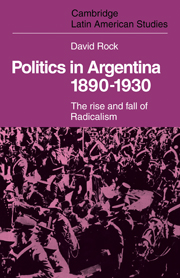Book contents
- Frontmatter
- Contents
- Preface
- 1 The components of Argentine society, 1890–1914
- 2 The oligarchy and institutional reform, 1880–1916
- 3 The rise of Radicalism, 1891–1916
- 4 The workers and their politics in Buenos Aires, 1890–1916
- 5 The first Radical government, 1916–22
- 6 The strikes, 1916–18
- 7 The Semana Trágica
- 8 1919
- 9 Postscript to the first presidency, 1920–2
- 10 The Alvear interlude, 1922–8
- 11 Yrigoyen's second presidency, 1928–30
- 12 Perspectives
- APPENDIXES
- 1 The occupational and class structure of the male population of the city of Buenos Aires by nationality, 1914
- 2 The rise of Radicalism – an historiographical note
- 3 The first Radical government and the Argentine Rural Society
- 4 The working class vote for the Radical and yrigoyenista parties in selected areas of Buenos Aires, 1912–30
- Select bibliography
- Index
1 - The components of Argentine society, 1890–1914
Published online by Cambridge University Press: 04 August 2010
- Frontmatter
- Contents
- Preface
- 1 The components of Argentine society, 1890–1914
- 2 The oligarchy and institutional reform, 1880–1916
- 3 The rise of Radicalism, 1891–1916
- 4 The workers and their politics in Buenos Aires, 1890–1916
- 5 The first Radical government, 1916–22
- 6 The strikes, 1916–18
- 7 The Semana Trágica
- 8 1919
- 9 Postscript to the first presidency, 1920–2
- 10 The Alvear interlude, 1922–8
- 11 Yrigoyen's second presidency, 1928–30
- 12 Perspectives
- APPENDIXES
- 1 The occupational and class structure of the male population of the city of Buenos Aires by nationality, 1914
- 2 The rise of Radicalism – an historiographical note
- 3 The first Radical government and the Argentine Rural Society
- 4 The working class vote for the Radical and yrigoyenista parties in selected areas of Buenos Aires, 1912–30
- Select bibliography
- Index
Summary
The hub of Argentina's economy, and Argentine society, between 1890 and 1914 was the export sector. Argentina's exports were made up of agricultural and pastoral products, of which the most important were wheat, maize, linseed, hides, wool and beef. Apart from during occasional periods of severe drought or depression, each year after 1890 Argentina exported up to 10 million tons of cereals. After 1900, following the introduction of refrigerated ships and meat-packing plants, meat exports of different types averaged out to a further total of about 350,000 tons. Between 1872 and 1915 the total cultivated area in Argentina rose from 580,000 hectares to 24 million. There was much to justify a panegyrist's claim in 1911 that ‘no country in the world has ever in so short a time realised so rapid a progress, in respect of the produce of the soil’. A few years earlier a former president of the republic, Carlos Pellegrini, had written:
This Republic possesses all the requisite conditions of becoming, with the passage of time, one of the great nations of the earth. Its territory is immense and fertile, its surface being equal to that of all Europe save Russia; it is capable of supporting with care at least 100 millions of human beings; almost every climate is to be found within its limits, and, consequently, it can yield all products, from those of the tropics to those of the polar regions.
- Type
- Chapter
- Information
- Politics in Argentina, 1890–1930The Rise and Fall of Radicalism, pp. 1 - 24Publisher: Cambridge University PressPrint publication year: 1975
- 1
- Cited by

